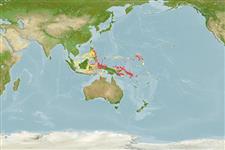>
Acanthuriformes (Surgeonfishes) >
Pomacanthidae (Angelfishes)
Etymology: Chaetodontoplus: Greek, chaite = hair + Greek, odous = teeth + Greek, plous, ous, oo = crossing (Ref. 45335); poliourus: Named for its grey caudal fin.
More on authors: Randall & Rocha.
Environment: milieu / climate zone / depth range / distribution range
বাস্তুসংস্থান
সামুদ্রিক রীফ সংশ্লিষ্ট; গভীরতার পরিসীমা 1 - 20 m (Ref. 90102). Tropical
Western Pacific: Papua New Guinea, Solomon Islands, Palau and Indonesia.
আকৃতি / ওজন / Age
Maturity: Lm ? range ? - ? cm
Max length : 8.6 cm SL পুরুষ/ লিঙ্গ অনিধর্ারিত ; (Ref. )
Short description
সনাক্তকারী নির্দেশক | বহিঃ অঙ্গ সংস্থান | মরফোমেট্রিক্স
পৃষ্ঠীয় কাঁটা (মোট ) : 12; পৃষ্ঠীয় নরম পাখনা দন্ড (মোট ) : 17; পায়ূ কাঁটা : 3; পায়ূর নরম পাখনা্তুন্ড: 16 - 17; কশেরুকা : 24. This species is distinguished by the following characters: D XII,17 (rarely 16or 18); A III,16 or 17; pectoral rays 15-17 (usually 16); small scales, about 80 in longitudinal series; dorsal series of pored lateral line scales 29-35; gill rakers 4 + 12; supraneural bones 2; body depth 1.70-1.85 in SL; head length 3.15-3.3 in SL; fourth to sixth dorsal spines longest, 1.1-1.3 in HL. Preserved color head and anterior body pale yellowish grey to an approximate oblique demarcation connecting base of second to third dorsal spine to anus, gradually changing posteriorly in an intermediate zone containing pectoral fin to one of irregular longitudinal lines on dark brown; a dark brown bar from nape, broadening as it passes through eye, then curving and narrowing as it ends shortly before origin of pelvic fins; front of lips brown; dorsal and anal fins colored as adjacent body; caudal fin abruptly pale grey; paired fins pale yellowish. Color in life: dark brown posteriorly with white dots, which merge anteriorly to form narrow irregular white lines; dark brown of body progressively lighter anteriorly, becoming pale grey at demarcation, then gradually changing to pale yellow on head; ocular bar black, narrowly edged in bluish white; snout and chest yellow, the front lips blue which sometimes continue as a narrow triangle medially in front of snout; first 3-4 dorsal spines and membranes yellow, the rest of fin dark brown with rows of white dots paralleling rays on about basal 3/4 of fin; narrow white or blue margin on soft part of fin; anal fin similar, but not yellow anteriorly; caudal fin grey with a narrow yellow posterior border; pectoral fins pale grey; pelvic fins bright yellow (Ref. 82330).
Very close to Chaetodontoplus mesoleucus (Bloch, 1787) with different colors on pelvic, dorsal and caudal fins. The two species coexist in several islands of Indonesia (Ref. 82330). These islands include Lesser Sunda Islands. Molucca Islands, Halmahera, and Bird's Nest Peninsula of West Papua (Ref. 90102).
Life cycle and mating behavior
পরিপক্কতা | প্রজনন | ডিম ছাড়া | ডিমসমূহ | ডিম্বধারন ক্ষমতা | শুককীট
Randall, J.E. and L.A. Rocha, 2009. Chaetodontoplus poliourus, a new angelfish (Perciformes: Pomacanthidae) from the Tropical Western Pacific. The Raffles Bull. Zool. 57(2):511-520. (Ref. 82330)
IUCN Red List Status (Ref. 130435: Version 2024-1)
Threat to humans
Harmless
Human uses
হাতিয়ার
Can't connect to MySQL database fbquizv2. Errorcode: Too many connections
